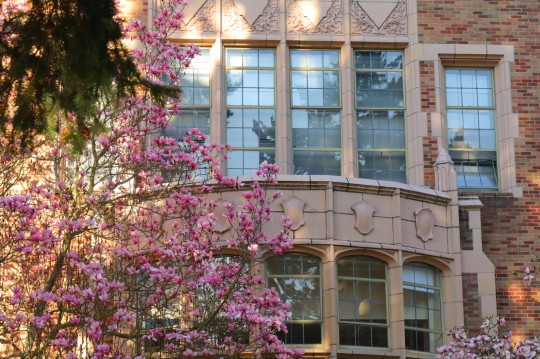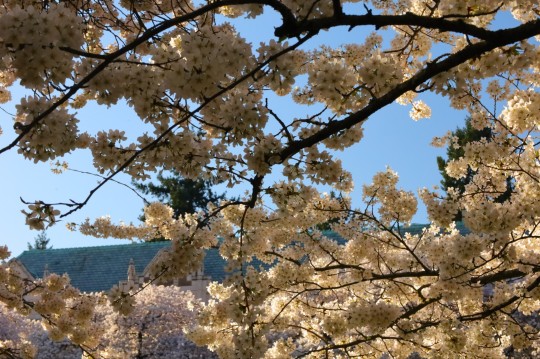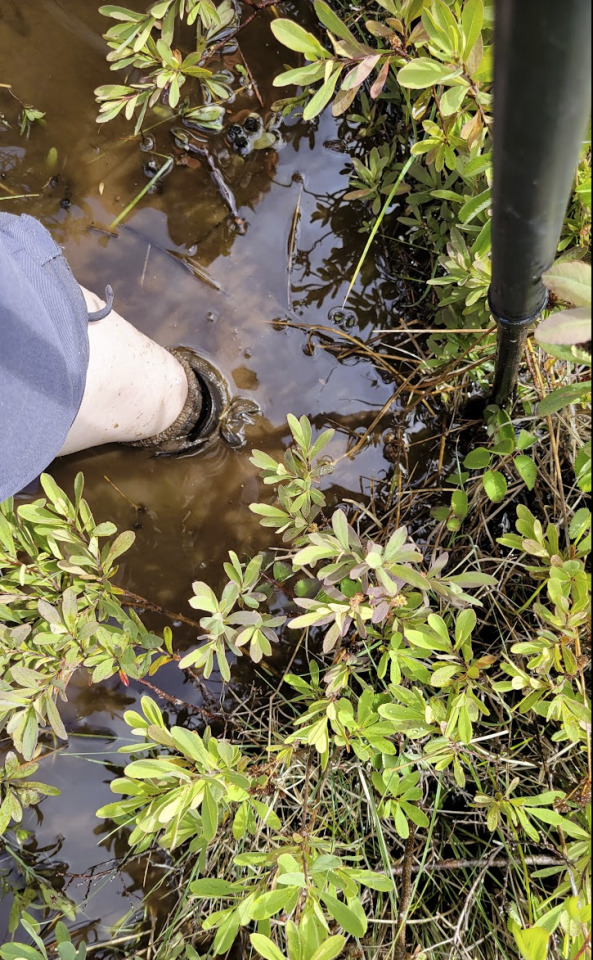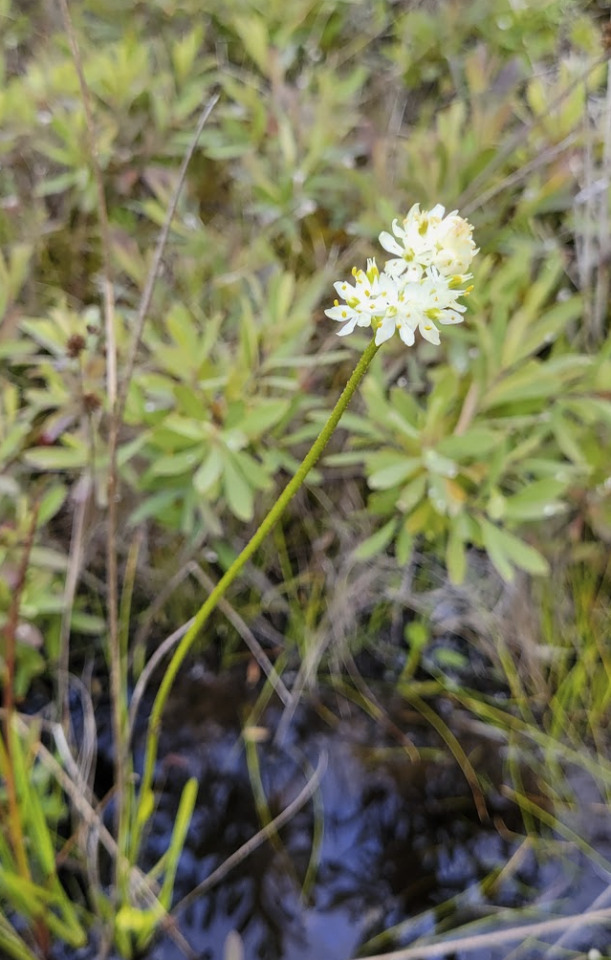#Plants of Washington State
Explore tagged Tumblr posts
Text

A plant I had been hoping to see for years! This is a striped orchid, Corallorhiza striata. There are a few Corallorhiza species where we go hiking in Washington State, but this one is one of the less common to see. You're more likely to spot C. maculata or C. mertensiana, called spotted and Pacific coralroots, respectively. I found this one on the Olympic Peninsula while backpacking up the Elwha.

Corallorhiza orchids, the coralroots, are mycoheterotrophic, meaning they parasitize mycorrhizal fungi instead of using photosynthesis like most plants. This means they'll just die if someone tries to cultivate them, which is honestly probably a good thing, given how threatened orchids are by poaching.
#Corallorhiza striata#striped orchid#plants of Washington State#Corallorhiza#coralroots#orchids#if you poach orchids know that I am waiting for you#:)#start running
161 notes
·
View notes
Text

Bogbean🌱 4.12.23
#plants#water plants#bogbean#plantblr#plant photography#flower#water#greenery#pond#lake#garden#plants of tumblr#plant pictures#original photographers#photography#photographer#canon photography#original photography on tumblr#photooftheday#photoblog#nature#nature photography#outdoors#pacific northwest#pnw#washington#washington state#canon#original art#original post
155 notes
·
View notes
Text




Washington forest by Jack Dykinga
#washington state#green#green forest#forest#woods#ferns#moss#green moss#mossy#lush forest#botanical#landscape photography#trees#plants#nature
292 notes
·
View notes
Link

The western bumble bee (Bombus occidentalis), one of the focal species of the conservation strategy, is currently under review for listing under the Endangered Species Act. This specimen was collected on western mountain aster (Symphyotrichum spathulatum) at a site on the Okanogan-Wenatchee National Forest south of Cle Elum and photographed as part of the Pacific Northwest Bumble Bee Atlas. After recording information about the bee it was released, unharmed. (Photo: Ed Lisowski.)
2K notes
·
View notes
Text
District of Columbia 🌳⛲🌿 TBT


#United States Capitol Complex#Lower Senate Park#New Jersey Avenue#Tree#Plants#Park#Walkway#Fountain#Lafayette Square#Lafayette Park#Pennsylvania Avenue#Washington D.C.
70 notes
·
View notes
Text
"Around the capital beltway or Washington’s famous Rock Creek Park, you may see a group of people ripping up vines along the treeline beside the roads.
If you have then you’ve glimpsed superheroes who traded in their capes for gardening gloves and their time for the satisfaction of terminating an invasive species and saving a native tree.
Washington D.C’s “Weed Warriors” are a group of volunteers going back to 1999 that work for free to keep hundreds of species of invasive shrubs, vines, and climbers from taking over native ecosystems.
Among the 600 or so non-native invasive plant species found in and around our nation’s capital, some like Polygonum perfoliatum, also known as “mile-a-minute” vine, can be devastating. Suffocating trees by overgrowing the leaves in their canopy branches, mile-a-minute can kill thousands of trees every year.
Since 1999, Weed Warrior volunteers have logged over 135,000 hours of time weed whacking in Montgomery County alone. Anyone can become a Weed Warrior; the group works in units for two-hour spaces removing weeds or planting native species in their place.
These invasive species management events are led by specially-trained volunteer Weed Warrior Supervisors and/or staff from the Montgomery Parks Dept. Warriors can get certified to de-weed in their spare time, or lead events on their own. They can even have their own unique patch of ground in the D.C.-Metro area to control.
Why would anyone want to trade their free time or laboring hours away for free doing something our tax dollars are supposed to do for us? The answer is simple: it’s addicting.
“If I have any good mental health, it’s due to Weed Warrioring,” said 74-year-old area resident Barbara Francisco. “You have a sense of accomplishment.” ...
The Weed Warriors website states that non-native, invasive plant species (NNIs) can alter the complex webs of plant-animal associations that have evolved over thousands of years to such a degree that plants and animals once familiar to us are eliminated...
Anyone who feels this is something they want to contribute their time to can go to the Montgomery County Parks website here and look at the upcoming Weed Warrior events—the next one is October 21st."
-via Good News Network, October 12, 2023
#washington dc#maryland#montgomery county#biodiversity#invasive species#invasive plants#vines#weeding#united states#volunteer#collectiveaction#planetearthfirst#forests#parks#good news#hope
161 notes
·
View notes
Text

Plant-based substitute for fossil fuels developed for plastic foams
An environmentally-friendly preparation of plant material from pine could serve as a substitute for petroleum-based chemicals in polyurethane foams. The innovation could lead to more environmentally friendly versions of foams used ubiquitously in products such as kitchen sponges, foam cushions, coatings, adhesives, packaging and insulation. The global market for polyurethane totaled more than $75 billion in 2022. A Washington State University-led research team used an environmentally-friendly preparation of lignin as a substitute for 20% of the fossil fuel-based chemicals in the foam. The bio-based foam was as strong and flexible as typical polyurethane foam. The researchers report on their work in the journal ACS Sustainable Chemistry & Engineering.
Read more.
#Materials Science#Science#Plants#Foams#Plastics#Polymers#Washington State University#Lignin#Biomaterials
14 notes
·
View notes
Text




University of Washington, in bloom. 2024.
This will be one of MANY cherry blossom posts. I apologize ahead of time.
#aesthetic#aesthetics#nature#seattle#vintage#washington#washington state#cherry blossom#nature photography#tree#trees#university of washington#spring#outdoors#city photography#university#bloom#flowers#flower photography#flower#cherry tree#plants#dreamy#sunny#sunny day#pretty#beautiful#beauty
72 notes
·
View notes
Text
This is a big deal! While the importance of pollinators has been in the headlines more over the past few years, a lot of the focus has gone toward European honey bees, which are not native here in North America. This new plan focuses specifically on our native bumble bees, to include severely declining species like the western bumble bee (Bombus occidentalis).
What's really cool is that they've targeted the ecoregions that are likely to have the most species of threatened bumble bees. It doesn't mean they won't do anything elsewhere, but when you have limited resources you want to make them have as much impact as possible.
In the meantime, consider this a reminder to add some native plants to your yard, garden, and/or porch, say no to pesticides and other yard chemicals unless absolutely necessary, and spend a little time learning about the native pollinators in your area!
#pollinators#bees#save the bees#bumblebees#bumble bees#insects#invertebrates#animals#wildlife#native species#native plants#Washington#Washington State#PNW#Pacific Northwest#entomology#science#scicomm#endangered species#conservation
387 notes
·
View notes
Text
Becoming one with the bog


It was technically a 'poor fen', not a bog in the strictest sense, because it's ground-and-surface water fed, not reliant entirely on rain. It's still on the acid side of neutral and dominated by sphagnum moss. The acid and lack of oxygen in the water mean the plant matter doesn't fully decay, which forms the 'peat' of the peat bog, and the sphagnums help make sure it all stays that way.
The peat fen is a sensitive ecosystem, and it's totally possible to sink one of the 'dry' feeling hummocks (they're NOT dry, they're lying; sphagnum can hold a huge amount of water), so you don't walk from hummock to hummock; you avoid them and wade through the water and mud.

It makes very satisfying SSHCHLORP and GLOOOP sounds, stealthily tries to eat your feet if you stand still too long, and it bounces. The ground was actually something like 20 feet below us; we were walking on the peat. I think they said that 90% of the water was in that peat, with 5% below and 5% above. Not sure I've got the numbers right, but picture a giant neutrally buoyant sponge. With a landscape on top of it. It is sproingy.
Bounce, and the shrubs and stunted trees bounce with you, or whatever that saying is.


We saw three species of carnivorous plants. I didn't get a picture of the bladderwort, but the left is a Washington native sundew, and the right is sticky false asphodel, which was only discovered to be carnivorous in 2021.
I also took lots of pictures of pond lilies, which aren't specific to this environment but are really cool looking:



They also make it warmer inside their flowers. That's part of why all the lil' bugs are there! Pond lilies be making it cozy. Swamp lantern (skunk cabbage) also generate heat — and they create their own little 'wells'; clear space in the sphagnum hummocks. None of my pictures captured it well, but it's quite weird. Like little variations on the massive "plant shaping it's environment" theme that the sphagnum moss started.
And that, it turns out, is the true lure and danger of the fen. Not just that it could schloop you under (I only fell on my ass once, and it was sproingy). Not will-o-the-wisps. No, the true mystery is the sphagnum hillocks themselves.

Mounds of moss rising a foot or more above the water, red, brown, chartreuse, and yellow. They look like little hills, but it's moss, moss, moss, all the way down. You can wiggle your hand right down inside it. It's incredibly soft, and it's warm.
I can just imagine someone, weary from their bog slog, starting to miss their footing in the gloop, falling prey to the siren song of the Forbidden Coziness. They lay down (crushing numerous delicate plants as they do). They wriggle in. They fall asleep.
Several thousand years later, a lucky archeologist finds another bog body.
#fens#bogs#peat bog#Washington state#botany#become one with the bog#pacific northwest native plants#pacific northwest#plant nerd#so much mud#schloop schloop schloop#carnivorous plants
45 notes
·
View notes
Text

Abstract Oil Painting of The Farm of Flowers
Click here to watch The World
#purple flowers#america#news#public news#united states#washington news#business#usa news#us news#usa politics#washington dc#flowers#floral#plants#greenery#botanical#farmers#farmcore#farm animals#farmhouse#dairy farm software bd#countryside#farmlife#garden#flower painting#painting art#painting#realism#oil painting#contemporary art
4 notes
·
View notes
Text

Sagittaria latifolia, called wapato or the more unwieldy "broadleaf arrowhead," is native to most of North America, and everywhere it grows, it has historically been eaten by many, many Native American and First Nations peoples. Still is, in some places! The tubers, while bitter raw, can be eaten like potatoes, being steamed, boiled, or dried and processed later. That said, like a lot of wetland plants, it can absorb pollutants, so if you'd like to try it, I'd advise growing your own and looking for a solid, well-tested recipe.
I like the Confluence Project's article about wapato, which includes more about the history of wapato in the Columbia River area. Here's a section:
In the 1820’s, Native Americans showed the adventuresome botanist David Douglas the secrets of wapato harvesting and he thrived on them almost exclusively when in the field. Wapato is very bitter if eaten raw, but like potatoes they may be boiled, steamed or fire-roasted. Indigenous people dried them, too, for soups or pounded them into cakes (and traded them to newcomers like Lewis and Clark) or ground dried wapato into flour. Other edible parts of wapato include the tender unfurling leaves and stalk. Boil them like other greens. The flower stalk before it blossoms and the lateral tips of the immature rhizomes are also edible, raw or cooked. The white petals of the blossom are tasty raw with a mild mint flavor. [6] In 2011, this sacred first food returned to the Yakama Nation. Wheat lands were transformed to original wetlands after a decades-long restoration process carried out by the tribe. Wapato also returned after a seventy year “respite.” [7] Wapato was as important to the Yakama diet as other sacred foods like salmon or huckleberries. To celebrate and to reintroduce this first food, a school gym was designated as the feasting hall and laid out like traditional longhouses. By introducing it to students, tribal elders felt that future generations would now have the opportunity to preserve traditions and sacred rituals that had fallen out of practice. Student Emmanuelle Wallahee commented, “I was taught that nothing’s ever lost. It’s just been put away for awhile.” [8]
75 notes
·
View notes
Text

Theobroma cacao, United States National Botanical Garden Conservatory, National Mall, Washington, DC, 2017.
#plants#trees#theobroma cacao#pods#color#united states national botanical garden#national mall#washington dc#2017#photographers on tumblr
13 notes
·
View notes
Text

New here let's reblog let's be friends
#canada#los angeles#california#american politics#united states#washington state#emma watson#robert plant#university of cambridge#mcdonald's
6 notes
·
View notes
Text
"Wherever they appear (or reappear), the presence of wolves makes an impact, but not just symbolically or politically. Wolves are a keystone species that play a vital role in and bring balance to ecosystems.
For example, the now-famous 1995 reintroduction of wolves to Yellowstone National Park led to a surprising number of positive impacts for ecosystems in the region. Without their primary predator, elk had overgrazed much of the park. The resulting loss of vegetation negatively impacted populations of mice and rabbits, as well as the animals that prey on them. Songbirds found fewer available nest sites.
Even bears were impacted as the elk out-competed them for the berries they relied on. In riparian areas throughout the park, the absence of wolves had even more drastic impacts. Overgrazing in riparian areas led to erosion and stream sedimentation and a reduction of the abundance of beavers, fish, insects, birds, and river otters, compromising the health of entire aquatic systems. With wolves back in the mix, the ecosystem rebounded."
277 notes
·
View notes
Text
Minnesota pink and green granite hexagonal monolith. ⛲🌹

#Senate Fountain#Fountain#Tree#Plants#Rose#Flowers#Senate Garage Fountain#Lower Senate Park#United States Capitol Complex#New Jersey Avenue#Washington D.C.
64 notes
·
View notes